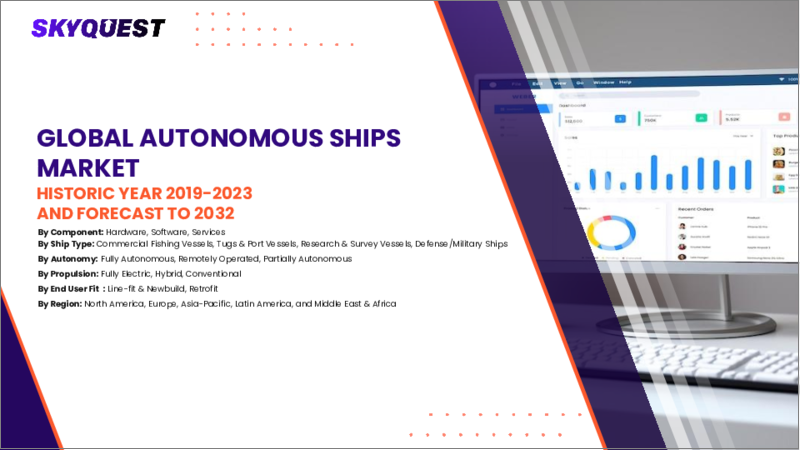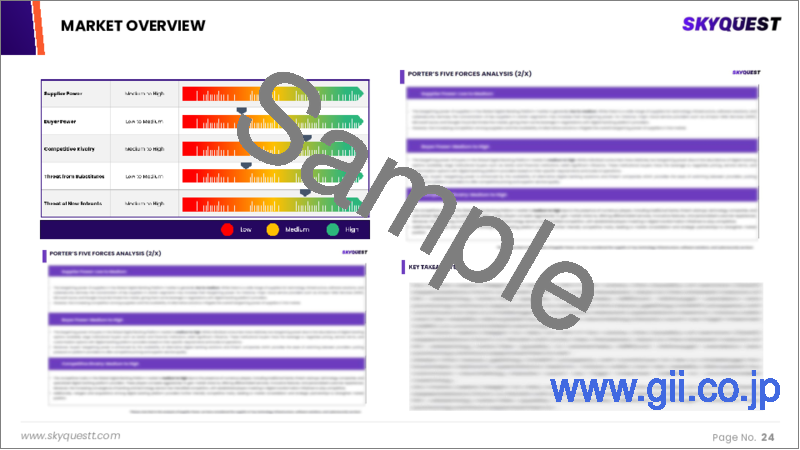|
|
市場調査レポート
商品コード
1701470
自律型船舶の市場規模、シェア、成長分析、船種別、ソリューション別、推進力別、自律性別、エンドユーザー別、地域別 - 産業予測 2025-2032年Autonomous Ships Market Size, Share, and Growth Analysis, By Ship Type (Commercial, Military), By Solution (Hardware, Software), By Propulsion, By Autonomy, By End Users, By Region - Industry Forecast 2025-2032 |
||||||
|
|||||||
| 自律型船舶の市場規模、シェア、成長分析、船種別、ソリューション別、推進力別、自律性別、エンドユーザー別、地域別 - 産業予測 2025-2032年 |
|
出版日: 2025年04月02日
発行: SkyQuest
ページ情報: 英文 202 Pages
納期: 3~5営業日
|
全表示
- 概要
- 目次
自律型船舶の世界市場規模は、2023年に44億米ドルと評価され、予測期間(2025-2032年)のCAGRは9.8%で成長し、2024年の48億3,000万米ドルから2032年には102億1,000万米ドルに成長する見通しです。
自律型船舶市場は、AI、高度なセンサー、リアルタイムのデータ分析などの技術の進歩に後押しされ、勢いを増しています。これらの船舶は、最適化された燃料消費と排出削減を提供し、輸送における世界のグリーン・イニシアティブに合致することで、その持続可能性の利点がますます認識されるようになっています。世界化が加速する中、効率的で信頼性の高い海運ソリューションへの需要が高まり、自律型船舶は世界貿易における業務効率と信頼性の向上に不可欠な資産として位置づけられています。世界各国の政府は、こうした技術を促進するための支援政策を採用する一方で、規制のハードルやサイバーセキュリティへの懸念といった課題にも直面しています。このような障害にもかかわらず、この市場は主要な企業にとって大きなビジネスチャンスであり、業界が近代化とデジタルトランスフォーメーションを受け入れることによって、運用コストの削減と柔軟性の向上が期待できます。
目次
イントロダクション
- 調査の目的
- 調査範囲
- 定義
調査手法
- 情報調達
- 二次と一次データの方法
- 市場規模予測
- 市場の前提条件と制限
エグゼクティブサマリー
- 世界市場の見通し
- 供給と需要の動向分析
- セグメント別機会分析
市場力学と見通し
- 市場概要
- 市場規模
- 市場力学
- 促進要因と機会
- 抑制要因と課題
- ポーターの分析
主な市場の考察
- 重要成功要因
- 競合の程度
- 主な投資機会
- 市場エコシステム
- 市場の魅力指数(2024年)
- PESTEL分析
- マクロ経済指標
- バリューチェーン分析
- 価格分析
- 規制情勢
- ケーススタディ
- 技術分析
自律型船舶市場規模:船種別& CAGR(2025-2032)
- 市場概要
- 商業用
- 軍隊用
自律型船舶市場規模:ソリューション別& CAGR(2025-2032)
- 市場概要
- ハードウェア
- ソフトウェア
自律型船舶市場規模:推進力別& CAGR(2025-2032)
- 市場概要
- 完全電動
- ハイブリッド
- 従来型
自律型船舶市場規模:自律性別& CAGR(2025-2032)
- 市場概要
- 完全自律
- 遠隔操作
- 部分的に自律
自律型船舶市場規模:エンドユーザー別& CAGR(2025-2032)
- 市場概要
- ラインフィットと新造
- 改造
自律型船舶市場規模:地域別& CAGR(2025-2032)
- 北米
- 米国
- カナダ
- 欧州
- ドイツ
- スペイン
- フランス
- 英国
- イタリア
- その他欧州地域
- アジア太平洋地域
- 中国
- インド
- 日本
- 韓国
- その他アジア太平洋地域
- ラテンアメリカ
- ブラジル
- その他ラテンアメリカ地域
- 中東・アフリカ
- GCC諸国
- 南アフリカ
- その他中東・アフリカ
競合情報
- 上位5社の比較
- 主要企業の市場ポジショニング(2024年)
- 主な市場企業が採用した戦略
- 最近の市場動向
- 企業の市場シェア分析(2024年)
- 主要企業の企業プロファイル
- 企業の詳細
- 製品ポートフォリオ分析
- 企業のセグメント別シェア分析
- 収益の前年比比較(2022-2024年)
主要企業プロファイル
- Kongsberg Gruppen ASA(Norway)
- Rolls-Royce plc(United Kingdom)
- Wartsila Corporation(Finland)
- HD Hyundai Heavy Industries Co., Ltd.(South Korea)
- DNV AS(Norway)
- Siemens AG(Germany)
- Honeywell International Inc.(United States)
- L3Harris Technologies, Inc.(United States)
- ABB Ltd.(Switzerland)
- Fugro(Netherlands)
- BAE Systems plc(United Kingdom)
- Hyundai Heavy Industries Co., Ltd.(South Korea)
- Marlink B.V.(Netherlands)
- Wartsila SAM Electronics GmbH(Germany)
- General Electric Company(United States)
- A.P. Moller-Maersk Group(Denmark)
- NYK Line(Nippon Yusen Kabushiki Kaisha)(Japan)
- Northrop Grumman Corporation(United States)
- Kymeta Corporation(United States)
- Cargotec Corporation(Finland)
結論と提言
Global Autonomous Ships Market size was valued at USD 4.4 billion in 2023 and is poised to grow from USD 4.83 billion in 2024 to USD 10.21 billion by 2032, growing at a CAGR of 9.8% during the forecast period (2025-2032).
The autonomous shipping market is gaining momentum, fueled by advancements in technology, including AI, sophisticated sensors, and real-time data analytics. These vessels are increasingly recognized for their sustainability benefits, offering optimized fuel consumption and reduced emissions, aligning with global green initiatives in transportation. As globalization accelerates, the demand for efficient and reliable shipping solutions heightens, positioning autonomous ships as a vital asset in enhancing operational efficiency and reliability in global trade. Governments worldwide are adopting supportive policies to promote these technologies, while also facing challenges such as regulatory hurdles and cyber-security concerns. Despite these obstacles, the market presents substantial opportunities for key players, with potential for reduced operational costs and increased flexibility as the industry embraces modernization and digital transformation.
Top-down and bottom-up approaches were used to estimate and validate the size of the Global Autonomous Ships market and to estimate the size of various other dependent submarkets. The research methodology used to estimate the market size includes the following details: The key players in the market were identified through secondary research, and their market shares in the respective regions were determined through primary and secondary research. This entire procedure includes the study of the annual and financial reports of the top market players and extensive interviews for key insights from industry leaders such as CEOs, VPs, directors, and marketing executives. All percentage shares split, and breakdowns were determined using secondary sources and verified through Primary sources. All possible parameters that affect the markets covered in this research study have been accounted for, viewed in extensive detail, verified through primary research, and analyzed to get the final quantitative and qualitative data.
Global Autonomous Ships Market Segments Analysis
Global Autonomous Ships Market is segmented by Ship Type, Solution, Propulsion, Autonomy, End Users and region. Based on Ship Type, the market is segmented into Commercial and Military. Based on Solution, the market is segmented into Hardware and Software. Based on Propulsion, the market is segmented into Fully Electric, Hybrid and Conventional. Based on Autonomy, the market is segmented into Fully Autonomous, Remotely Operated and Partially Autonomous. Based on End Users, the market is segmented into Line-fit & Newbuild and Retrofit. Based on region, the market is segmented into North America, Europe, Asia Pacific, Latin America and Middle East & Africa.
Driver of the Global Autonomous Ships Market
The global maritime sector is vital for international trade, as shipping serves as the main method for transporting goods across borders. With the continuous rise in global trade volumes, there is an escalating demand for more effective and dependable shipping solutions. Autonomous ships present a promising opportunity to improve the capacity, speed, and overall efficiency of maritime transportation, thereby addressing the increasing need for enhanced shipping operations. This trend highlights the growing significance of autonomous vessels in meeting the demands of heightened shipping activities in a rapidly evolving global market.
Restraints in the Global Autonomous Ships Market
The Global Autonomous Ships market faces significant constraints due to the ongoing evolution of regulatory and legal frameworks. There is a pressing need for well-defined guidelines and international standards to effectively tackle issues concerning liability, accountability, and adherence to maritime laws. The lack of comprehensive regulations contributes to uncertainties that can impede the broader acceptance and implementation of autonomous ships. Until these regulatory challenges are addressed, the market is likely to experience hurdles that may slow down progress and innovation within the sector. Establishing a clear legal framework is essential for fostering confidence and facilitating the integration of autonomous vessels into the maritime industry.
Market Trends of the Global Autonomous Ships Market
The Global Autonomous Ships market is experiencing a significant trend towards the development of modular and scalable solutions that are revolutionizing maritime operations. These innovations not only provide the flexibility to retrofit existing vessels with cutting-edge autonomous technologies but also facilitate the seamless integration of such systems into newly designed ships. By allowing for a gradual, step-by-step implementation, modular systems minimize disruption and associated costs for ship operators. Meanwhile, scalable solutions empower customization tailored to various vessel types and operational demands, enhancing efficiency and operational effectiveness. This trend is likely to accelerate the adoption of autonomous technologies across the maritime industry, driving growth and investment in the sector.
Table of Contents
Introduction
- Objectives of the Study
- Scope of the Report
- Definitions
Research Methodology
- Information Procurement
- Secondary & Primary Data Methods
- Market Size Estimation
- Market Assumptions & Limitations
Executive Summary
- Global Market Outlook
- Supply & Demand Trend Analysis
- Segmental Opportunity Analysis
Market Dynamics & Outlook
- Market Overview
- Market Size
- Market Dynamics
- Drivers & Opportunities
- Restraints & Challenges
- Porters Analysis
- Competitive rivalry
- Threat of substitute
- Bargaining power of buyers
- Threat of new entrants
- Bargaining power of suppliers
Key Market Insights
- Key Success Factors
- Degree of Competition
- Top Investment Pockets
- Market Ecosystem
- Market Attractiveness Index, 2024
- PESTEL Analysis
- Macro-Economic Indicators
- Value Chain Analysis
- Pricing Analysis
- Regulatory Landscape
- Case Studies
- Technology Analysis
Global Autonomous Ships Market Size by Ship Type & CAGR (2025-2032)
- Market Overview
- Commercial
- Military
Global Autonomous Ships Market Size by Solution & CAGR (2025-2032)
- Market Overview
- Hardware
- Software
Global Autonomous Ships Market Size by Propulsion & CAGR (2025-2032)
- Market Overview
- Fully Electric
- Hybrid
- Conventional
Global Autonomous Ships Market Size by Autonomy & CAGR (2025-2032)
- Market Overview
- Fully Autonomous
- Remotely Operated
- Partially Autonomous
Global Autonomous Ships Market Size by End Users & CAGR (2025-2032)
- Market Overview
- Line-fit & Newbuild
- Retrofit
Global Autonomous Ships Market Size & CAGR (2025-2032)
- North America (Ship Type, Solution, Propulsion, Autonomy, End Users)
- US
- Canada
- Europe (Ship Type, Solution, Propulsion, Autonomy, End Users)
- Germany
- Spain
- France
- UK
- Italy
- Rest of Europe
- Asia Pacific (Ship Type, Solution, Propulsion, Autonomy, End Users)
- China
- India
- Japan
- South Korea
- Rest of Asia-Pacific
- Latin America (Ship Type, Solution, Propulsion, Autonomy, End Users)
- Brazil
- Rest of Latin America
- Middle East & Africa (Ship Type, Solution, Propulsion, Autonomy, End Users)
- GCC Countries
- South Africa
- Rest of Middle East & Africa
Competitive Intelligence
- Top 5 Player Comparison
- Market Positioning of Key Players, 2024
- Strategies Adopted by Key Market Players
- Recent Developments in the Market
- Company Market Share Analysis, 2024
- Company Profiles of All Key Players
- Company Details
- Product Portfolio Analysis
- Company's Segmental Share Analysis
- Revenue Y-O-Y Comparison (2022-2024)
Key Company Profiles
- Kongsberg Gruppen ASA (Norway)
- Company Overview
- Business Segment Overview
- Financial Updates
- Key Developments
- Rolls-Royce plc (United Kingdom)
- Company Overview
- Business Segment Overview
- Financial Updates
- Key Developments
- Wartsila Corporation (Finland)
- Company Overview
- Business Segment Overview
- Financial Updates
- Key Developments
- HD Hyundai Heavy Industries Co., Ltd. (South Korea)
- Company Overview
- Business Segment Overview
- Financial Updates
- Key Developments
- DNV AS (Norway)
- Company Overview
- Business Segment Overview
- Financial Updates
- Key Developments
- Siemens AG (Germany)
- Company Overview
- Business Segment Overview
- Financial Updates
- Key Developments
- Honeywell International Inc. (United States)
- Company Overview
- Business Segment Overview
- Financial Updates
- Key Developments
- L3Harris Technologies, Inc. (United States)
- Company Overview
- Business Segment Overview
- Financial Updates
- Key Developments
- ABB Ltd. (Switzerland)
- Company Overview
- Business Segment Overview
- Financial Updates
- Key Developments
- Fugro (Netherlands)
- Company Overview
- Business Segment Overview
- Financial Updates
- Key Developments
- BAE Systems plc (United Kingdom)
- Company Overview
- Business Segment Overview
- Financial Updates
- Key Developments
- Hyundai Heavy Industries Co., Ltd. (South Korea)
- Company Overview
- Business Segment Overview
- Financial Updates
- Key Developments
- Marlink B.V. (Netherlands)
- Company Overview
- Business Segment Overview
- Financial Updates
- Key Developments
- Wartsila SAM Electronics GmbH (Germany)
- Company Overview
- Business Segment Overview
- Financial Updates
- Key Developments
- General Electric Company (United States)
- Company Overview
- Business Segment Overview
- Financial Updates
- Key Developments
- A.P. Moller-Maersk Group (Denmark)
- Company Overview
- Business Segment Overview
- Financial Updates
- Key Developments
- NYK Line (Nippon Yusen Kabushiki Kaisha) (Japan)
- Company Overview
- Business Segment Overview
- Financial Updates
- Key Developments
- Northrop Grumman Corporation (United States)
- Company Overview
- Business Segment Overview
- Financial Updates
- Key Developments
- Kymeta Corporation (United States)
- Company Overview
- Business Segment Overview
- Financial Updates
- Key Developments
- Cargotec Corporation (Finland)
- Company Overview
- Business Segment Overview
- Financial Updates
- Key Developments






